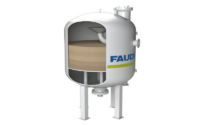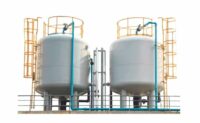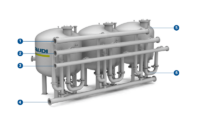
Bed filters: Layer filters (P62)
Water is a valuable resource and an increasingly scarce property due to growing demand from the population, industry, energy production and agriculture. Therefore, water treatment plays an important role in the availability of drinking and process water in long-term. FAUDI offers modular filtration solutions, such as the layer filter, for partial water treatment tasks.
The layer filters, also called dual or multi-media filters, are used to reduce the suspended solids (turbidity) content in seawater or process water. Suspended solids consist of small particles such as sludge, clay, grit, organic substances, algae and other microorganisms. Feedwater with high levels of suspended solids can cause a high-pressure loss and affect the effectiveness of downstream equipment and processes.
Filtration takes place by physically restraining contaminants in the intermediate spaces between the granules of the individual filter layers. Regeneration is accomplished by means of back flushing.
Application areas for this filtration technology is the filtration of seawater for desalination, as service and cooling water as well as the use as injection water. Furthermore, in the filtration of industrial water, waste water and process water as well as in the bypass filtration in cooling circuits.
We are able to complement our standard sizes in welded construction as needed with project-specific products using adapted dimensions and materials – tailored to your application, both for fresh and salt water.
Benefits: Your advantages
at a glance
Very high filtration rates
up to 50 m³/h m²High dirt holding capacity (500 mg/l)
Very low backflush water consumption of 0.1% to 1%
Continuous, fully automatic operation
Exceptional filtration quality due to matched filter media
Long service life of the filter media
Low space requirements
Modular design and ready-to-use
units or skids

How does a layer
Filter work?
A dual or multi-media filter typically contains two or more layers of filter media consisting of anthracite charcoal, sand, garnet, etc., plus a supporting (non-filtering) support layer at the bottom. The larger (but lighter) anthracite is on top and the heavier (but smaller) garnet remains at the bottom. The layers of filter media allow the largest dirt particles to be removed from the top of the media bed, with the smaller dirt particles being retained further and further down in the media. This allows the entire filling to act as a filter, allowing much longer filter run times between back flushing and more efficient particle removal.
Water flows through several layers of different grain size from the top to the bottom. During this process, sediments/contaminants are retained in the filter bed.
Start into your next
PROJECT WITH US now
We are your contact for engineering, piping design as well as monitoring and control.
Industries: Where They are used
Application areas: How they are used





